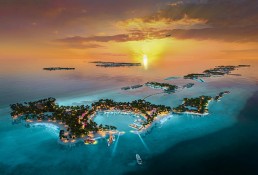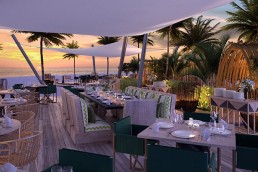REVIEW: Crossroads, Maldives
In line with the Ministry of Tourism’s drive to diversify the accommodation offer in the Maldives, Singha Estate unveils the nation’s first integrated resort destination – an ambitious development spanning hospitality, retail and entertainment.
Serving as a maritime pit stop on the ancient Silk Road, the Maldives once would have provided shelter to weary travellers navigating from east to west and vice versa. In this heyday of trading on the oceans, cargo such as paper, gunpowder, porcelain and spices was transported from China and South Asia via Arabia to Europe, with horses, wool, gold and glass favoured on the return. Ship crews of different cultures, charged with handling these precious commodities, would have visited the Maldivian islands to take onboard new stocks and supplies while making repairs to their ocean-battered vessels. It is this historical legacy that Singha Estate’s multi-island leisure and lifestyle destination taps into, positioning itself as a modern meeting point for a new generation of explorers in the 21st century.
A NEW PROPOSITION
In place of the traditional one-island-one-hotel norm, the Thai developer has introduced an integrated resort concept to the Maldives, one that aims to be the largest of its kind in the Indian Ocean when complete. Out of nine interconnecting reclaimed islands, two have so far been developed: the first comprising the 11,000m2 Marina at Crossroads and its adjoining hotel, SAii Lagoon Maldives; the second occupied by Hard Rock Hotel Maldives.
From the same family stable of businesses that includes Boon Rawd Brewery, Crossroads operates under the hospitality arm of Thai real estate company, Singha Estate. Representing S Hotels & Resorts’ first flagship development of an integrated leisure destination, the nine-island complex spans the seven-kilometre-long Emboodhoo Lagoon and seeks to make the most of its accessibility, just 15 minutes by speedboat, from Malé International Airport. Elaborating, Chief Operating Officer Thiti Thongbenjamas says: “With the benefit of this location, we can attract potential new markets such as groups of friends, MICE travellers and local residents as well as transit passengers. By reviving the rich history of the Maldives as a destination for people from all walks of life, we’re set to bring a new lifestyle concept to the islands while working closely with local communities to promote the culture and history of the nation.”
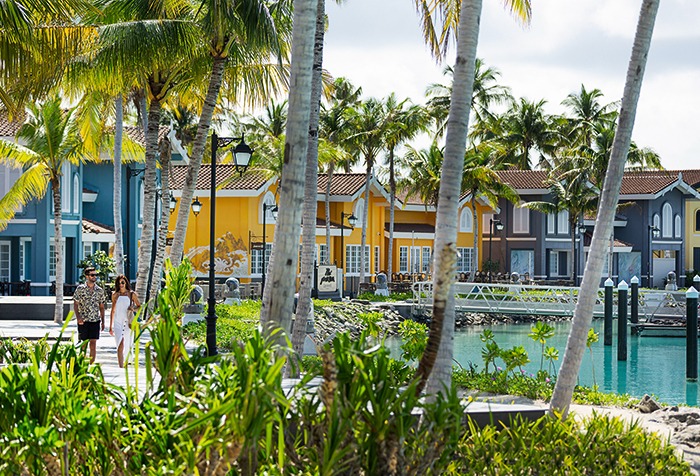
One of the main attractions for Maldivian residents and transit passengers is the variety of tenants, approximately 70 in total, dotted around the marina, including big-name dining options such as Café del Mar, Ministry of Crab and Hard Rock Café. Retailers range from tea specialists to perfumers while an event hall is aiming to capture meetings, incentive and wedding business. Additionally, there is a yacht marina that can accommodate up to 30 luxury vessels. Tropical architecture with nods to a colonial aesthetic pervades the complex, where buildings are lent interest by hand-drawn paintings referencing the Maldives as a cultural melting pot.
SUSTAINABILITY SPOTLIGHT
Phase one of the project, part of a US$311.5 million investment, has not been without its critics from an environmental point of view, with the initial stages of reclamation called out for carelessness. Since this early hiccup, however, Singha Estate has partnered with international agencies, local authorities and communities to ensure the sustainability aspect of construction, while the highly-respected Thai marine biologist, Dr. Thon Thamrongnawasawat, has been appointed to lead on coral preservation and regeneration initiatives as well as social education. Picking up on the theme, Thongbenjamas outlines how construction has followed the protocol of the United Nations’ Sustainable Development Goals with efforts concentrated on “closely measuring the marine environment, reducing wet work and avoiding discharge of grey water plus ensuring strict zero waste to the ocean”. At the Marine Discovery Centre – a facility that promotes environmental conservation and Maldivian local arts and crafts – interactive storyboards and installations draw visitors into the midst of an educational project focused on coral propagation while the resort’s two hotels use energy efficient LED lighting, waste management including composting and organic gardens, as well as a heat recovery system to power hot water.
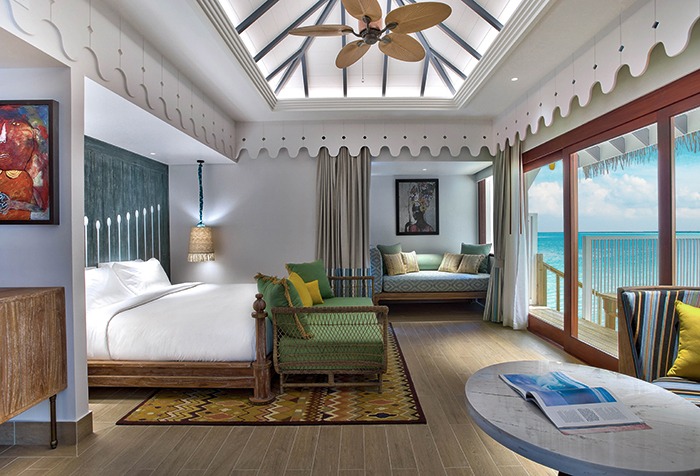
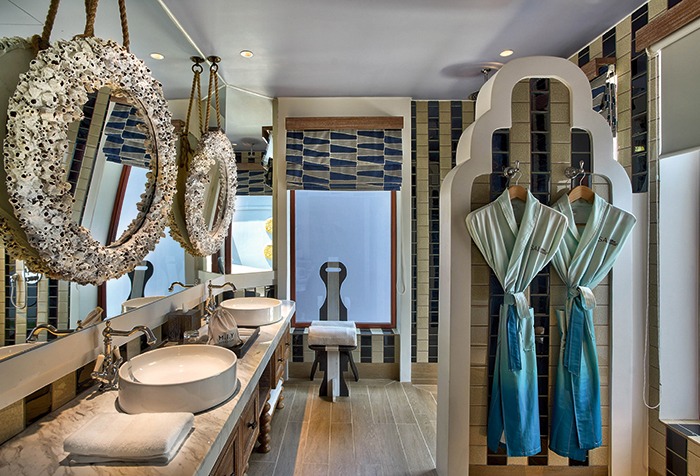
SAII LAGOON
Part of Hilton’s Curio Collection, the 198-room SAii Lagoon has been conceptualised by S Hotels & Resorts as an enhancement of the marina, offering an intimate, chilled-out hospitality experience at an affordable price.
Emblazoned with quirky art, textiles, fabrics and handpainted surfaces that reference a fusion of cultures, the property speaks equally of a colonial past as conveyed by Portuguese tiling and shutters. Landscaping and bespoke furniture weaves its way around the restaurants and strategically positioned pool bar, while hints of Asia and Arabia combine in an eclectic confluence of distinctive design, lifted by splashes of cerulean blue and sunshine yellow.
HARD ROCK HOTEL
Linked to the Marina by a 450m bridge equipped with Bose speakers, the high-energy vibe of Hard Rock International’s first Maldivian hotel is evident from the moment of arrival at the music organ-shaped welcome pavilion, with its drum-inspired reception booths. Guests are whisked up to the main resort block and invited to slide down a water chute to collect a mocktail once safely across the pool. Activities galore on land, water and in the air keep the social and buzzy atmosphere of the self-contained property going through day into night, when lighting and furniture changes create ambient mood shifts.
Charged with designing the 178-key hotel, Singapore-based Eco-id Architects collaborated with an oceanography expert, the developer and Hard Rock to shape the manmade island, prioritising beach frontage for public areas while carving out spaces for activity hubs and creating scenery vignettes. “Once the masterplan had been established, it was a case of working on architecture with a contemporary tropical direction,” outlines the firm’s Director Carol Chng. “The island then became a showcase for the curation of these building forms.”
Interpreting the music ethos of the Hard Rock brand in its own way, Eco-id has infused a free-spirited quality into its vision, opting for airy and contemporary design over traditional Maldivian thatched roof structures. “Our take is a composition of clean forms without sacrificing light, ventilation and shade,” confirms Chng. “So you see white architectural massing shine in the sunlight, contrasting and accentuating the blue and green hues of the water – like monuments to the rock-star lifestyle, they have a rebellious design angle.” Alongside white concrete and masonry, painted in ocean shades for overwater guest villas, synthetic thatched roofs have been selected to respond to the climate and timber for curving overwater walkways.
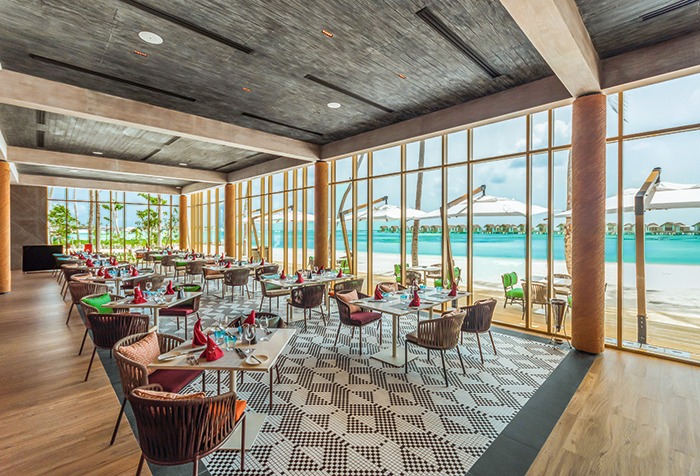
MUSIC AND MOVEMENT
While the brand’s music DNA is an essential factor, Maldivian culture has also been absorbed into the interior design approach, with the Boduberu another key source of inspiration. “To us, the image of locals dancing to the rhythm of drums on the beach is such a clear definition of music, the Maldives and Hard Rock,” describes Chng. “From the Boduberu tradition, we have extracted tactile elements such as the Maldivian mat, drum shapes, lacquer techniques and coir rope effects.” Around the resort, the art of Maldivian weaving is expressed as diagonal and graphic line motifs seen in tiling and panelling, while rhythmic bands of colour characterise timber louvered screens and villa entrance doors. Drum armchairs, rattan cocoon seating, rope-clad columns and intricate multi-hued tile installations bring pops of bright colour into the scheme with vibrant paintings by Maldivian artist Shaff Oceans a common feature in each guestroom. In combination with Hard Rock’s trademark music memorabilia dotted around public spaces, interiors are dynamic and youthful. “Memorabilia displays are juxtaposed with interior colours, patterns and textiles – a blend of local culture interpreted and abstracted with dialled-up energy,” explains Chng. “As music is synonymous with movement, we try not to keep things static.
Standout spaces include The Elephant & The Butterfly, a pan-Latin restaurant and oceanfront pool bar that pays homage to Frida Kahlo and Diego Rivera, its plates of food purposefully contrasting the rustic with the sophisticated. A playful ceiling fixture of suspended colour beads moves and sways to make a group of butterflies materialise while gold and white mosaics accentuate the same theme. Shaff Oceans’ memorable handpainted elephant wall mural took months of refinement but is now an Instagram hit.
Elsewhere, Sessions – serving dishes inspired by contemporary global flavours – is a vibrant all-day dining affair, and on a more sybaritic note, Rock Spa makes an impression for its abstract architectural rendition of a wave crashing on seashells. Finally, the largest guest villa, appropriately named Rock Star, has been designed to redefine the tropical house party with its jukebox, tuk-tuk bar and carousel shaped as a seahorse. “From masterplanning to architecture and interiors, the total composition is akin to putting notes together to form a tune,” concludes Chng. “The vitality of Hard Rock’s DNA is on display in every aspect of the sensory experience.”
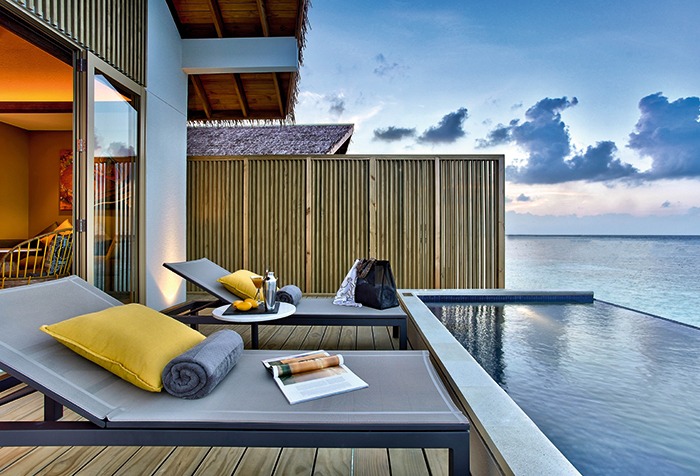
BUILDING BIG, PROTECTING THE SMALL
With the first phase of development now operational, Singha Estates has turned its attention to what’s still to come. The next phase of Crossroads, which is due to open up a third island in 2022, will include a high-end lifestyle resort comprising 80 spacious villas for experiential travellers, built in partnership with Myanmar’s Eco World Developer.
While the project is monumental in both scale and ambition, Crossroads is committed to its mission of ‘building big, protecting the small’, preserving the natural beauty of the Maldives and enriching the lives of locals.
“With Crossroads, we are making history,” commented Chutinant Bhirombhakdi, Chairman, Singha Estate, on the resort’s debut. “By being the largest integrated leisure and entertainment destination in the Maldives, Crossroads is going to redefine vacation experience in the entire Indian Ocean region, while also being deeply sustainable and considerate of its environment, history and culture.”
Words: Neena Dhillon
Images: Courtesy of Singha Estate
This article originally ran in Sleeper 88.
Related Posts
27 October 2016
Kanuhura Maldives renovated
30 November 2015
European Hotel Design Awards 2015
21 January 2015
